#and it’s the latter that had a more positive and prominent part of this year
Text
HAPPY NEW YEARS!!
#alright time for me to sleep now#ALKSKSKS#IM KIDDING IM KIDDING#this year has been uh a lot on me for a lot of reasons#some in the worst of ways#but in the best of ways too#and it’s the latter that had a more positive and prominent part of this year#i’ve met a lot of amazing moots on here#a lot of who i call as friends#i’ve been slowly improving myself in so many ways too!!#may it be writing drawing or coding#or just me myself#when it comes to a few issues i have#it’s slow#and sometimes i may even backtrack#but i’d always jump back in#and it’s what makes me happy#oh but it’s definitely my moots too tho#most of which i look forward to every day#and some times the one thing i look forward too when the days start to grow harder and harder#so thank you#to oli#to melon#to rei#to vi#to so many others too#even if we don’t talk as much#you all became a part of my familiar in a way that i didn’t notice at first#but am grateful at the end of the day#i love you all so much
11 notes
·
View notes
Text
By the end of the second millennium, the religious thinkers of Mesopotamia saw the cosmos as controlled and regulated by male gods, with only Ishtar maintaining a position of power. When we see such a pattern of theological change, we must ask whether the religious imagery is leading society, or whether it is following socioeconomic development? Was the supplanting of goddesses in Sumerian religious texts an inner theological development that resulted purely from the tendency to view the world of the gods on the model of an imperial state in which women paid no real political role? Or does it follow in the wake of sociological change, of the development of what might be called "patriarchy"? And if the latter is true, is the change in the world of the gods contemporary to the changes in human society, or does it lag behind it by hundreds of years? To these questions we really have no answer. The general impression that we get from Sumerian texts is that at least some women had a more prominent role than was possible in the succeeding Babylonian and Assyrian periods of Mesopotamian history. But developments within the 600-year period covered by Sumerian literature are more difficult to detect. One slight clue might (very hesitantly) be furnished by a royal document called the Reforms of Uruinimgina." Uruinimgina (whose name is read Urukagina in earlier scholarly literature) was a king of Lagash around 2350 B.C.E. As a nondynastic successor to the throne, he had to justify his power, and wrote a "reform" text in which he related how bad matters were before he became king and described the new reforms that he instituted in order to pursue social justice. Among them we read, "the women of the former days used to take two husbands, but the women of today (if they attempt to do this) are stoned with the stones inscribed with their evil intent." Polyandry (if it ever really existed) has been supplanted by monogamy and occasional polygyny.
In early Sumer, royal women had considerable power. In early Lagash, the wives of the governors managed the large temple estates. The dynasty of Kish was founded by Enmebaragesi, a contemporary of Gilgamesh, who it now appears may have been a woman; later, another woman, Kubaba the tavern lady, became ruler of Kish and founded a dynasty that lasted a hundred years. We do not know how important politically the position of En priestess of Ur was, but it was a high position, occupied by royal women at least from the time of Enheduanna, daughter of Sargon (circa 2300 B.C.E.), and through the time of the sister of Warad-Sin and Rim-Sin of Larsa in the second millennium. The prominence of individual royal women continued throughout the third dynasty of Ur. By contrast, women have very little role to play in the latter half of the second millennium; and in first millennium texts, as in those of the Assyrian period, they are practically invisible.
We do not know all the reasons for this decline. It would be tempting to attribute it to the new ideas brought in by new people with the mass immigration of the West Semites into Mesopotamia at the start of the second millennium. However, this cannot be the true origin. The city of Mari on the Euphrates in Syria around 1800 B.C.E. was a site inhabited to a great extent by West Semites. In the documents from this site, women (again, royal women) played a role in religion and politics that was not less than that played by Sumerian women of the Ur IlI period (2111-1950 B.C.E.). The causes for the change in women's position is not ethnically based. The dramatic decline of women's visibility does not take place until well into the Old Babylonian period (circa 1600 B.C.E.), and may be function of the change from city-states to larger nation-states and the changes in the social and economic systems that this entailed.
The eclipse of the goddesses was undoubtedly part of the same process that witnessed a decline in the public role of women, with both reflective of fundamental changes in society that we cannot yet specify. The existence and power of a goddess, particularly of Ishtar, is no indication or guarantee of a high status for human women. In Assyria, where Ishtar was so prominent, women were not. The texts rarely mention any individual women, and, according to the Middle Assyrian laws, married women were to be veiled, had no rights to their husband's property (even to movable goods), and could be struck or mutilated by their husbands at will. Ishtar, the female with the fundamental attributes of manhood, does not enable women to transcend their femaleness. In her being and her cult (where she changes men into women and women into men), she provides an outlet for strong feelings about gender, but in the final analysis, she is the supporter and maintainer of the gender order. The world by the end of the second millennium was a male's world, above and below; and the ancient goddesses have all but disappeared.
-Tikva Frymer-Kensky, In the Wake of the Goddesses: Women, Culture, and the Biblical Transformation of Pagan Myth
#Tikva Frymer-Kensky#Ishtar#female oppression#mesopotamian mythology#goddess erasure#ancient history#religious history
26 notes
·
View notes
Text
Todays rip: 07/02/2024
Battle Emergency
Season 4 Episode 2
Featured on: Paper Jams - A High-Quality Album ~ The First Fold
Ripped by Cryptrik
youtube
Requested by circunflexo! (@circunflexonoa)
Over its life, there's been a lot of projects on SiIvaGunner where it's easy to tell they were driven by individual rippers' passions, moreso than satiating the hunger of a wider audience. There's of course Jass' excellent Genesis renditions of the soundtrack to Sonic CD, as shown in Collision Chaos Good Future JP [CD Beta Mix], there's ShonicTH's push for Kingdom Hearts content to be on the channel with rips like Trial of the Heart, and of course Chaze the Chat's legendary infatuation with pop music sensation Sean Kingston in Take You To The Desert - with no particularly strong feelings toward any other music artists of the 2000s. Yet of these projects listed, I don't think any of them felt quite as prominently featured on the channel as the three-part Paper Jams project.
Prominent channel member PinkieOats, of Live and Ooooooooooooooh, was once on an episode of the now-ended SiIvaGunner interview podcast series "The High Quality Podcast" (which, ftr was a huge inspiration for me to start this blog!). From just that one hour of time spent listening to PinkieOats alone, I could tell that the guy REALLY loved the first two Paper Mario games - hell, his profile picture since time immemorial has been of a pink Boo enemy rendered in the Paper Mario artstyle. Just a few months after said podcast episode, SiIvaGunner revealed "Paper Jams - and it thus came as no surprise to me to learn that it was a successor to a 2015 project by PinkieOats and Nape Mango, five whole years earlier. The goal of Paper Jams? To, across a collection of album, rip *every single track* from Paper Mario: The Thousand-Year Door.
The tracks wouldn't all be ripped by PinkieOats and Nape Mango this time, of course - they now had the entire SiIvaGunner team collaborating with them for this rather ambitious event, and the results of that collaboration are evident as clear as day with Cryptrik's Battle Emergency. I've covered Cryptrik's work in the past with rips like Maroonbound and Give Me the Fantasy, and it was actually my coverage on the latter rip that prompted today's requestee to suggest yet more of the guy's rips for the blog. But it really cannot be stressed enough just how effortlessly Cryptrik is consistently able to make his rips just sound flat-out FUN, in large thanks to his mastery of utilizing large amounts of pure *noise* in rips. It would not surprise me one bit if I learned he was an actual DJ, but his influences are immensely clear regardless - dude rocks, basically.
Battle Emergency straddles a fantastic line in my eyes between succumbing entirely to Cryptrik's noise-driven style and still maintaining the original charm of The Thousand-Year Door's music - a balance that I believe is important to have in mind whilst working for a tribute project like Paper Jams in particular. The whimsical, energetic vibe of the Battle Theme lying underneath it all doesn't get lost, but is coated in an absolute barrage of mostly funk-related songs - primarily led by FUNK EMERGENCY, but joined by parts from Walk the Dinosaur, Uptown Funk, and the ever-memorable melody of Black Betty (bam-ba-lam), really just letting Cryptrik go wild with his signature style.
And yeah - it all works to excellent effect! The rip often reminds me of rips like Everybody's Special Course or Memey Hell in how the amount of noise and scattershot sources only aid in giving the track a fun, exciting feel - like you're at the center of two concerts playing at once and having the best time of your life. Its the kind of rip that almost leaves you exhausted after you're done listening - yet also the kind of rip that's endlessly relistenable as a result for how many phases it goes through in such a standard runtime. Althewhile the positive energy it instills also serves to spills over into my impression of Paper Jams as a whole - it truly sells the idea that, though the project was started by PinkieOats and his own passion, it is one that so many others of the SiIva team love just as much and want to celebrate just as loudly. Because really - moreso than colleagues, isn't the SiIvaGunner team really just a bunch of musicians who love jamming out to one another's music?
#todays siivagunner#season 4 episode 2#siivagunner#siiva#Cryptrik#Youtube#Bandcamp#Paper Jams#paper mario#paper mario ttyd#super mario#mario#mario games#super mario rpg#mario rpgs#mario & luigi#m&l rpgs#ttyd#ttyd remake#pm ttyd#pmtok#spm#super paper mario#Uptown Funk#Marc Rebillet
18 notes
·
View notes
Text

[Map: the colonial empires of the seven major states of the Issaran Heptarchy. These states were Ferrense (yellow), Eytal (red), Obreya (blue), Kimar (teal), Asshar (orange), Nelente (green), and Segel (violet).]
The Issaran Heptarchy is the conventional name for a group of states in Issara, in southwest Rezana, that achieved prominence during the Andemoro Period, about six hundred Sogantine years after the collapse of the Lende Empire. Issara had been experiencing several centuries of political consolidation at this point, and also was connected to extensive maritime trade routes, many of which had been created by the Lende Empire and persisted after its fall. Of the nine or so major regional powers, seven were well-positioned to take advantage of those routes; though the principle concerns of Asshar and Nelenta always remained their overland empires.
Fierce competition between the Issaran states, which coincided with the introduction of ever-deadlier weapons, the first stirrings of local industrialization, and coalitional politics that prevented any single state from gaining a preeminent position, led the Issaran rulers to seek opportunities for territory and wealth outside their core territories. The first to do so was Nelente, which preyed on weaker states along the northwest coast, and Ferrense, which used its powerful navy to raid overseas, establishing what was basically a pirate empire in the ocean between the Gelar Sea and the Windlands. Issaran traders soon established themselves in Démora, western Vinsamaren, the more populous parts of Karei, and even Nebressa and Sayyedhu, though the highly organized states of the latter two regions prevented the kind of explicit empire-building that was possible in other regions. But by far the most profitable conquests were in Adwera, which became the focus of Issaran politics.
Issara had long had trade connections with Adwera to the north, mostly through intermediaries along the eastern coast of Rezana; when Kimaran traders sought to eliminate those intermediaries and acquire valuable Adweran goods directly, it sparked a particularly fierce four-way competition between Kimar, Obreya, Eytal, and Segel for dominance in the region. The outcome of this struggle was eventually total Issaran domination of the subcontinent. Only peripheral regions like the deep deserts of Shushtat and the Mosheri coast remained independent. The Adwerans, who were politically and culturally disunited to begin with, eventually banded together to drive out the Issaran invaders, a process that took around a hundred and fifty years of bitter warfare. The costs of this war, renewed fighting in Issara itself, and the expense of colonial projects that turned out to be boondoggles more often than not, eventually led to the decline of Issaran imperialism.
11 notes
·
View notes
Note
Well, time for my autistic hyperfixation skills to shine! Here's your cheat-sheet for what Halo EU media to skip to for the good parts (aka aliens):
Since you've already read The Cole Protocol, Envoy is a rlly good skipping point. Besides the greatness that is Rojka 'Kasaan, and it having a pretty notable Jiralhanae villain, it's also written by the same author and follows up on the Gray Team storyline introduced in the former book.
Hunters in the Dark also makes the top of my list for fleshing out the Halo 3 co-op characters N'tho 'Sraom and Usze 'Taham and giving us nice cross-species positive interactions. Also can't forget Broken Circle, as it's all Sangheili and San'Shyuum in the story, no humans for once. It's split between two timelines: the era of the Covenant's founding and the time of Halo 2.
The Ferrets series of books (Last Light, Retribution, and Divine Wind so far) features the reoccurring antagonistic faction the Keepers of the One Truth lead by the Jiralhanae named Castor. The Master Chief series also features Fleetmaster Nizat 'Kvarosee in the first two books (Silent Storm and Oblivion) and the Keepers in Shadows of Reach; haven't read them yet but I heard good things about Nizat so far and he seems to be one of the more unique in the lore, being kinda older than most Sangheili we've seen so far. Also can't forget the Halo CE novelization, The Flood, which featured the first portrayal of Covenant perspectives in canon I believe (and therefore some of the lore and characterization there is a bit off in comparison to the rest of the books, but it's fine). Zuka 'Zamamee and Yayap are a real treat in that one, even if the tone of their sections are a bit sillier than most (from my impression so far, haven't finished the book yet actually).
And I kind of have to include the Kilo-Five trilogy, although with the fair warning that they're a bit divisive amongst the fandom. You're either gonna like them or despise them. I think a majority people, regardless of how they feel about the trilogy as a whole, did find the alien sections fine though. If I had to re-read them again I'd probably skip to just those chapters. Jul 'Mdama is a prominent character in the first two books (Glasslands and The Thursday War), with his wife Raia 'Mdama having more of a spotlight in the second, but then the whole 'Mdama plotline wraps up and gets replaced by Kig-Yar Chol 'Von in Mortal Dictata (although she's a good character on her own and it's unfortunate her story never got picked up by other authors after the trilogy ended). Other notable aliens in the trilogy include Forze 'Mdama, Avu Med 'Telcam, Sav Fel, and probably the most concentration of named Huragoks in a Halo storyline ever. Thel also makes some appearances here too.
Speaking of the 'Mdamas tho; I haven't gotten to it yet but Legacy of Onyx does feature Jul and Raia's sons as major players post-Halo 5, plus I believe there is a Sangheili teacher character and maybe some rare alien kid characters. Ohhhh and I can't believe I almost forgot, but upcoming book Outcasts is gonna feature Thel as a main character again! Been waiting for it but it got delayed, we should finally be getting it in August tho. You may want to read the Master Chief books first tho since it looks like some lore introduced there will be featured here too, especially since it's the same author Troy Dennings.
Finally to round out the recs are the anthologies. I'd go for Fractures before Evolutions, as the former has Shadow of Intent with Rtas, Tul 'Juran, Vul 'Soran, Stolt, and Tem'Bhetek and Oasis with Jat (who existed for maybe a dozen pages but has captured my heart for years). Latter still has Henry (human nickname, we never learned his real name because of language barrier) in The Mona Lisa, some named Jiralhanae in Stomping on the Heels of a Fuss (which I forgot about so idk if it's because it's been years or if they did not have much of a role), and an unnamed Sangheili shipmaster who's the focus of The Return. The Return & The Mona Lisa also got "animated" adaptations in the form of voice-acted motion comics you can find on YouTube.
Those are all books but maybe I might as well throw in the comics. Obviously there's the Rise of Atriox miniseries. Also not as well known but there was a small prequel comic for the first Halo Wars which features Ripa 'Moramee's origin story; I got the physical copy as part of my game copy, idk if there's a way to access it digitally. The Halo Graphic Novel includes the famous Halo story The Last Voyage of the Infinite Succor feat Rtas 'Vadum and Thel in his Fleetmaster era. Haven't read it but Blood Lines has two Sangheili brothers as major antagonists. Tales From Slipspace has Atriox in Hunting Party and Avu Med 'Telcam in Knight Takes Bishop. Finally one of the more well known comics, Escalation has a few points of interest (note I haven't read all of 'em yet and going off Halopedia for this): Thel in Issues 1-3 + Jiralhanae Lydus, Jul 'Mdama and Sali 'Nyon in the Janus Key arc (Issues 13-16) and Absolute Record arc (Issues 19-24), and Ayit 'Sevi in Absolute Record arc.
And what the heck. let's get obscure: The Halo Wars Official Strategy Guide published by Prima Publishing includes some flash fiction featuring Ripa 'Moramee and The Prophet of Regret, because sometimes crumbs is all ya get. Halo: Legends - aka the official Halo anime - also has The Duel which shows an ancient Arbiter and why the title is considered dishonorable in modern Halo times.
Oh and... I guess there's the Forerunner trilogy, for like, Forerunners... tbh tho they're basically bootleggish humans to me, I rank them the lowest out of all the Halo aliens and don't really consider them most of the time when hyper-focusing on Halo aliens.
Gonna read this later
11 notes
·
View notes
Note
Hi! A Slovak... Supporter? Fan? Person that has agreed with a lot of your stuff? Anyway, you talked a lot about common history of Ukraine and Russia, but I was wondering about the Ukrainian perspective on the period in which we Slovaks lived with parts of the Ukrainian nation in one state, that is, the Habsburg monarchy and especially First Czechoslovak Republic. Like, what were you taught in school about Carpathian Ruthenia? Is this period remembered more positively or negatively?
Hiiiiiii Minette! I remember you <3
A quick disclaimer beforehead: I finished school before 2014, things might have changed since then. I will be referring to modern textbooks in order to fix the gap, but bear in mind I had no experience of learning from them and I don't know what the teachers are like today. But the general vibe I have from my school years is that we learned a lot about russian empire and Rzeczpospolita, but not nearly enough about other eastern european countries. Looking at the current programme, it seems like the things have improved since then somewhat.
The general imperssion I have left about the Habsburgs is that it was opressive towards ukrainian pesantry and ukrainian national distinctiveness, however in comparison with russian empire, some laws were better. It's kind of a "lesser of two evils" situation. There were many revolts, one of the most prominent being оприщина (idk how it's translated in slovak... but in polish they call them zbójnicy) that are generally perceived as a righful uprising against the unjust opression.
As for the First Czechoslovak Republic, I am surprised to see that modern books dwell more into it than I remember from my school years. (Although it might have been the proverbial "you were just drawing the eye" situation). In general, I'd say it's described with a lot of sympathy, with the exception of the times Czechoslovakia shut down the separatist movements and/or movements for unification with other ukrainian republics.
The history of Czechoslovakia has become a successful example of parliamentary democracy in Central and Eastern Europe. [...] Czech and Slovak politicians voluntarily agreed to unite. This union, combined with a relatively tolerant attitude to national cultures, allowed the state to strengthen.
- Історія: Україна і світ. 10 клас. Гісем
After the collapse of Austria-Hungary, the majority of the Ukrainian population of Transcarpathia spoke in favor of unification with the Ukrainian People's Republic. However, on May 8, 1919, the Central Ukrainian People's Council, created by representatives of Uzhhorod, Presov and Khust councils, proclaimed the unification of Transcarpathia with Czechoslovakia [...] where it was guaranteed the rights of autonomy. The Ukrainian population of the region in Czechoslovakia did not experience as much discrimination as in Poland or Romania.
- Підручник по Всесвітній історії. 10 клас. Щупак
In political development Czechoslovakia was the most democratic state in Europe.
[...]
T. Masaryk had close ties with Ukraine. He was sympathetic to the Ukrainian liberation struggle and supported Ukrainian emigration. In the years between the two world wars, the Ukrainian Free University, the High Ukrainian Pedagogical Institute named after M. Drahomanov, the Ukrainian art studio and the gymnasium were established and actively functioned in Prague.
[...]
In the Carpathian Ukraine and Slovakia, Hungarian national parties advocated the annexation of these lands to Hungary. Alongside them were Ukrainian political parties that sought autonomy for Carpathian Ukraine.
- Підручник по Всесвітній історії (рівень стандарту). 10 клас. Сорочинська
Those were just some passages relevant to your question, but for the most part the textbooks focus on Masaryk, the policial and economical systems of the Czechoslovaika, and the Munich agreement. On the topic of the latter, there is this one quote that I find sadly relevant:
From the statement of the Foreign Minister of Czechoslovakia K. Croft to the Ambassadors of England, France and Italy (September 1938): "For us it is a disaster… I do not know whether your countries will benefit from the decision taken in Munich. In one thing we are sure - we are certainly not the last, after us others will suffer."
Can't really speak for the "is it remembered more positively or negatively" aspect, becuase (a) this topic isn't brought up often in the current conversation about history, and (b) I don't have relatives from that region that could testify from their own personal experience. The impression I got from reading the textbooks is neutral to positive.
Thanks for the question, this was fun to research!
11 notes
·
View notes
Text
“The Colonel's nephew, John C. Hamilton, had become estranged from his wife and family, and about this time the former gave her employment as his housekeeper. Her son Edgar, devoted to the memory of his Uncle William, in later years gave some of the most intimate glimpses we possess, into the life at the mines. The Colonel had also a Negro servant boy, “Black Davie,” of whom Edgar writes kindly. The Hamilton cabin became rare meeting-place as time went on. Here, it is true, he boarded some of his rough and muddy miners, but here he also entertained most distinguished visitors. Here his fine, aristocratic mother, and his sister, Mrs. Holly, were his guests in 1837. And here would sometimes come crowding in a roomful of the natives bands of whom remained for five or six years after Black Hawk's day. They were beggars and thieves. Hamilton understood them, and had no fear of them. But he had to keep a watchful eye on the visitors to guard against being “robbed out of house and home.”
Says Muldoon, of the always interesting Colonel: “One day he could eat his ‘grub’ with his heavy-whiskered, ragged and mud-spatered miners; the next he could take his place to preside over a banquet of silk-clad and powder-haired aristocrats. He was an exceptionally clever conversationalist, when he did talk, but as a rule, was one of the silent type, doing far more, thinking than talking.”
From all sources we learn that Hamilton was unusually handsome, and from many that he was the “living image” of his illustratious father. He was of medium height and of medium stoutness. He stood 5 feet 7 inches in height and weighed 160 pounds. He had a light complexion and light brown hair. His eyes were blue and piercing. Strength, intelligence and kindliness all were marked in his fine face. He stood erect, was prompt and positive, and in every relation in life was the gentleman. He never married, nor, so far as is known, had a love affair. One of the finest tributes to the man, one that rings was paid by his friend of many years, Mr. Chas. H. Gratiot: “Col. Hamilton was an intimate friend of my family and a frequent visitor for many years. We esteemed him for his warm social instincts, his affability, his unassuming courteousness, his refinement and culture. He was virtuous, temperate and generous to a fault.”
“Col. Hamilton first opened the mines at Hamilton's Diggins in 1928, and spent most of the next twenty years in mining, meeting with good success until the water put a stop to his operations. Mr. Hamilton lived the life of a miner, a rough life at best, yet in his miner's cabin, the surroundings evinced the fine taste of the occupant. His library was the most valuable in the country, and contained, mostly, the books of classical authors.”
The friend with whom Hamilton first entered Galena, Daniel Parkinson, opened an inn at Mineral Point, thirty miles from Fort Hamilton, and here the Colonel could often be found with congenial friends, such men as General Dodge and the Gratiot brothers, discussing politics and sipping their cider, each taking his turn with some story of adventure in the wilderness. So, too, these men, and others well known in the lead district would meet before Hamilton's broad fireplace, or in his grocery store. Colonel Kellogg, or Captain Gentry was likely to be among them.
After the Indian war a post-office was established at the Diggings, and known as Fort Hamilton. The Colonel was again post-master. Now, more than ever, the store became the social center of the place. In 1833, he built a now needed school-house. Then followed a tavern, a saw-mill and a distillery. Fort Hamilton was growing. One matter is too interesting to omit. It concerns General Henry Dodge and the Colonel. From the time of Black Hawk's War to Colonel Hamilton's death in 1850, these two men were politically the foremost citizens of Wisconsin. Dodge was an ardent Democrat while Hamilton championed the Whig principles of his great father. Hamilton had always a keen tongue, when arcused and shortly before the Black Hawk War had made some statement which Dodge resented. After the fashion of the day. the latter challenged his Whig opponent to a duel. There was no hesitation on the part of the Colonel. We have the story from his nephew. The newphew, Col. Schuyler Hamilton, afterward of much prominence in the Civil War, says, “Uncle William replied that at that moment his country demanded his services; but if he survived until the war was over, he would be happy to oblige Mr. Dodge. Later, the war being over, Uncle William informed General Dodge that he awaited his convenience. But General Dodge replied frankly that he could have no quarrel with so brave a soldier and so true a gentleman as he had found Col. Hamilton to be, and begged to withdraw the challenge, and that they be friends. And they did become friends.” The incident speaks volumes for the mainliness of both men. Col. John Dement, of Dixon, married a sister of General Dodge, and Mrs. Dement spent her days thereafter at Dixon. She is known to have had the same fine openness of character as marked her distinguished brother.
Twice in his life on the frontier, as we are told, Colonel Hamilton visited his mother in the East-once from the Sangamon country and once from the lead mines, after the Black Hawk War. 1000 miles and he made it, like at knight of old, on horseback. But he did not stay long. Life in New York had become tame for him. It was a trip of His movements always had a suddeness and unexpectedness about them. Riding to the door one morning he told his mother, “I can't stand it here: I've got to get back where there is room,” and kissing her goodbye, he mounted his horse again and rode away.
In return, in the summer of 1837, the mother, accompanied by a daughter, Mrs. Sidney Holly, paid him a visit. Mrs. Hamilton was in her eighties, and the trip was a long one. From Pittsburgh on west it was by boat down the Ohio to Cairo and up the Mississippi to Galena. They took boat the middle of March and reached Galena June 1st. The courageous old lady was able, however, to meet every demand on her endurance. But the Colonel's cabin, “Fort Hamilton”, was too lacking in the comforts and refinements of living to be a suitable place to entertain his lady guests, so he shortly arranged for their entertainment in Galena, at the more elegant and comfortable home of his friends, Mr. and Mrs. J. P. B. Gratiot. Their historic old house is standing yet today.
Mrs. Gratiot writes of Mrs. Hamilton: “Pleasant and unaffected, she bore her eighty-four years with graceful dignity.” Not only the Gratiot home, but the entire community, showed her every courtesy and kindly attention. Her hosts took her on a trip to Fort Snelling where the ofifcers paid her distinguished honors, such as due the widow of Alexander Hamilton, She was always a devout church-woman. The Episcopalians of Galena had been kind to the Colonel in an illness, and were very kind to her, and it is told that she presented the church some communion silver. The writer has asked the present rector, the Rev. Mr. Ellsworth in regard to the gift, and he says it is not certain. but that they do have some old silver plate, of which no one now seems to know the origin. The visit lasted from June 1st to September 15th. It was set down by the diarists of the time as “the first great social event of the lead country.” The Colonel accompanied the ladies as far as St. Louis, on their return, and there, too, much was made of the patriotician old lady, of so many fine associations.
In the “Log Cabin and Hard Cider” campaign of 1840, the men of the Diggins, regardless of previous political affiliations, were enthusiastic Whigs. William Henry Harrison, victor over Tecumseh at the battle of Tippecanoe, and father of their fine young Captain at the stockade, was the Whig candidate. Moreover, it was confidently accepted that in the event of his election he would appoint their own beloved Colonel first Governor of the new territory of Wisconsin. The Whigs won the election, and Hamilton had so few plans laid for the governorship. Among them was that his mother and Mrs. Holly should be the ladies of his official household. He was boyishly happy in the prospect of being able so to honor and to gratify his aged mother.
It was no fault of “Old Tippecanoe” that Colonel Hamilton did not achieve this, the greatest political ambition of his lift. President Harrison died after only thirty days in office, and the post of President went to Vice President Tyler, a General appointed Democrat, who Dodge to the new governorship. Wisconsin was then Democratic, and the cards were stacked against the brave Colonel. Politically he enjoyed but one pronounced success, and that with the odds quite against him. His mineral region elected him to the first Territorial Convention of Wisconsin. There he was selected as chairman of the Convention and was recognized as easily the leading man in its deliberations. It was in 1843 that Hamilton changed the name of the Diggings, or Fort Hamilton, to Wiota, by which beautiful name the hamlet is still known. When, in 1847, Iowa County was subdivided, that part in which lay the Diggins was given the name “Lafayette's tribute to his friend, and his father's friend, General Lafayette. He made one more essay into politics. He was candidate, in 1848, for membership in the State Constitutional Convention. The vote was declared to be slightly against him. But there was little doubt the count had been erroneous. They could play politics in that day as well as this. Hamilton took his case before the convention itself. He is said to have made a masterly presentation of his claim, one that would have done credit to a Patrick Henry. But the majority were Democrats and voted solidly against him. He may well have forsworn all politics from that day on.
The California Gold Fields
Almost at the moment, however, arose a matter that would quite naturally crowd political questions from the mind of the adventure-loving Hamilton, anyhow. Word came East of the gold discoveries in California. He decided to join the gold-seekers. With all the zest that characterized the man, he spent the winter in preparing for overland trip the following spring. With the aid of the village black-smith he built two strong moving-wagons, and these he equipped for the journey. His proposed leaving saddened the home of his miners. But he assured his friends that he did not plan to be gone long, not more than a year or two. Then he hoped to return with money enough so that he could install pumps in the lead mines and give them all employment again.
Early the spring of ‘49 he started out with his two prairie schooners, soon to join one of the many long caravans heading across the plains and mountains. Hamilton himself, always a lover of good horses, dorve to the front wagon a span of beautiful blacks. One of the early settlers, a Mr. Engebretson long told of the brave appearance of the Colonel's team, with all its equipment new. The driver of the second wagon was a fine colored fellow named Barney Norris. It is likely that he drove mules. It would have been hard for oxen to keep pace with the Colonel's spirited blacks. Later, Norris returned to Galena, where he spent his days, far into old age, as sexton of the Presbyterian church. He was highly respected, and thought of, to the last, as Col. Hamilton's body servant. The Colonel and Barney got through in early summer.
They lost little time in prospecting, soon staking out their claim at a point about 100 miles north of Sacramento. The claim yielded fairly from the start. Profiting by his experience in the lead mines, Hamilton established a store, also, and sold supplies to the miners. He was $10,000 ahead at the end of twelve months. The stake he had set for the venture, before he should return to the Diggings, was $20,000. At this time a Sacramento firm, dealers in lumber and mining supplies, sold him an interest in their business. July 17, 1850, he was still at this “brush store” at the gold mines. July 30th, he was on his way to Sacramento. About October 1st a friend sought for him there, and was told by a member of the firm that a few weeks after joining them, Col. Hamilton had taken sick and died in the cholera then raging in the city. It was a period of terror, in which few records of any sort were kept.
The Colonel had been fortunate in having with him, in his last hours, fiends who stood by and gave him whatever attention and comfort was possible. His friend, Charles Gratiot and the faithful Barney were two of them. It was impossible to secure a coffin, but they found enough lumber to make at least a box. They accompanied his remains to the trench, where the cholera victims were being laid, and buried him as “No. 50” in the trench. They secured the services of a Baptist minister at the grave. One of the Colonel's brothers, in New York, having been informed of his death, wrote, requesting Mr. Gratiot to ship the remains East, but naturally enough, the navigation company would not carry the body of a cholera victim. It was 27 years later that an effort was made by a Wisconsin friend, the Hon. Cyrus Woodman, to locate the grave of Hamilton, with a view to the erection of a monument at the spot. The markers set up at the time of the burial had been of wood and were now rotted and gone. The faithful Barney, in Galena, over a quarter-century after the burial, now proved to be the one person who could so describe the location of the grave that it could be found. And it was. The remains were taken from the trench to an individual lot, and a good stone was placed at the head, by his old friend, Mr. Woodman. The inscription on it read:
COL. W. S. HAMILTON Born in New York Aug. 4 1797 Came to California in ‘49 Died October 8, 1850
In size and features, in talent and character, he much resembled his illustrious father.
A friend erects this stone.
Ten years later, Col. Hamilton's body found another, no doubt its final resting-place. The city of Sacramento furnished a larger lot, in a new and roomier part of the cemetery, naming it “Hamilton Square.” The Colonel's relatives in the East, at family expense, erected a stone there, dedicated to his memory, and bearing also, on one face, a bronze medallion of his father, Alexander Hamilton. Here may his rest be undisturbed!
Back by the village street in Wiota seems nevertheless, the most fitting spot for a memorial to the brave and lovable Colonel Hamilton. Here his heart was. And here, in his memory, where he was so long known and loved, the ladies of the D. A. R. have set a granite tablet, suitably inscribed. Near it stands a fine but necessarily temporary memorial painting, in bill-board form, showing, above, the Colonel's team and covered wagon, and below, a picture of the stockade. This, then, is what I have, at last, learned about William Stephen Hamilton, frequent visitor at early Dixon, friend of Father John Dixon, and son of great Alexander Hamilton.
THE END”
The “Sometime back” series, by L. B. Neighbour. Dixon Evening Telegraph (Illinois) [March 17, 1932]
#amrev#american history#jackson era#newspapers#history#william stephen hamilton#william s hamilton#william hamilton#barney norris#hamilchildren#hamilton family#hamilton kids#hamilton children#hamilkids#Cicero's history lessons
15 notes
·
View notes
Text
It’s A Mad, Ad World
When Google (1998) and Facebook (2004) started out, they were the garage band equivalents of technology firms. Truth be known, Larry Page and Sergei Brin really did launch Google in a garage, but Facebook had more lofty digs while Mark Zuckerberg was a student at Harvard. But none of them had a business plan, and the phrase “revenue model” hadn’t even entered into the Marketing lexicon yet.
But it would, and soon.
It’s one thing to attract venture capital funding, because it allows your business to get up and running, hire key employees, and fully develop the product or service offering. But those early investors are not doing so out of the goodness of their hearts; they expect a long-term return, and to do that, there has to be a way to make money.
It took a few years, but both Google and Facebook eventually realized that the only way they could make money was by selling advertising. This is true because people like you and me would never pay money to do a search, or to establish online connections with others. In the process, Google and Facebook became advertising companies, perhaps first and foremost.
And by virtue of that attainment, they necessarily became bogged down in all the privacy concerns of the day, because these two firms know a lot of personal information about us. This allows them to sell ads (and information) so that companies can target potential customers with laser-like precision. As we all know, it is often uncanny how ads seemingly just pop up that hit us squarely between the eyes.

While this is all good from an ad sales perspective (and maybe not so much if you are a privacy advocate), both firms still had one glaring weakness, a weakness that Amazon is now fully exploiting: Amazon Ads. I’m also pretty sure that founder Jeff Bezos, who also was a garage band success story, never thought of advertising in the early days either, to be fair.
Amazon has leaped into third place in terms of ad revenue, with $37.8 billion in 2022. Facebook is in second with $113.7 billion, while Google rules the roost with $224.5 billion. But Amazon has suddenly become a big threat to Facebook, and is considered responsible for Facebook’s recent revenue decline.
And it turns out that Amazon Ads are very different from the types of ads that Facebook and Google serve us. The latter two are trying to make good matches among prospects, while Amazon allows advertisers to place ads in front of people who have already started the shopping process. That’s powerful.
The most obvious ads shoppers encounter on Amazon are the “Sponsored” ones. Search for any product, and it is likely that the first couple of rows are items whose makers have paid for prominent placement. It is actually not at all unlike slotting fees in the grocery, with manufacturers paying the piper—I mean grocer—to have their products et eye level. Those Amazon ads are typically pay-per-click. Amazon makes money every time we click, and then a lot more when we actually buy an item.
The difference in advertising model is very clear. Whereas Facebook and Google allow for targeting people highly likely to buy something, and whom may have actually demonstrated some interest in doing so, an ad at Amazon hits people who have actually gotten started. These ads may feature a specific item the user queried, or “interceptor” products from competitors. Think of it as advertising a store, versus advertising within the store. Once people are in, they are probably pretty serious.
I understand why Facebook in particular is nervous. While it still holds a solid #2 position, Amazon holds another card, one we discussed a few days ago: livestream shopping. This is all part of the Amazon Ads experience. While Facebook and companion Instagram both have shopping as well as livestream capabilities, they are not in the retail position that Amazon is.
It is understandable that people feel like they are being crushed under an avalanche of advertising. Everywhere we turn, there are ads. But ads pay the bills, and in the case of Amazon, they supplement retail sales. Whereas ads make up 97.5% of Facebook’s revenues, they only account for 7.3% of Amazon’s revenues. This helps explain Facebook’s vulnerability; ad sales are just gravy on Amazon’s mashed potatoes. For the sake of comparison, Google’s ad sales are 79.3% of their revenues.
Meanwhile, our tech rockstars are all basking in the glow of advertising notoriety. None of them ever saw it coming, but they all realize now it is a vital part of their business. Now if we could just get everyone else on board with crafting a business plan and revenue model first.
Dr “Sell Me Something Good“ Gerlich
Audio Blog
3 notes
·
View notes
Note
I haven't watched Tar but I just want to say that discrimination in the classical music field needs to be talked about so much more. And i mean of everything just all of it the misogyny, racism, homophobia, transphobia, everything. I've had to sit quiet during people saying outright homophobic things just to not risk being kicked out of my orchestra in my youth symphony I was in many years ago. A conductor of mine was gay and I ended up knowing because I volunteered and helped out a lot but we never said a word and it felt like I was walking on eggshells everyday and honestly being terrified if anyone found out. He had a tattoo of the pink triangle on his upper arm and he always made sure it was covered but honestly everytime I think of him it makes me sad because I saw him crumble under his anxiety and depression that no doubt was worsened by the community. The only confirmation we ever gave each other was the time we challenged each other to a "who has the best bowtie" competition and I showed up with a rainbow bowtie... He gave me the tightest hug and said, "I like yours better".
There were two other people I knew that were gay & bi and that was it. The former tried to be open about it and in a way suffered because he was, he ended up leaving quickly after, and again the only confirmation we ever gave each was the time I wore a small pride pin... He saw it, looked at me, smiled, gave me a knowing nodd and said, "cool pin". The latter person told me out right that she was Bi and others too but after that everyone started to treat her different, she started to show up with constant bruises and injuries, some to the point that she was limping and couldn't even play her cello and their was always an excuse from her and her mom. I tried to say something but nobody did anything but rolled their eyes and told me I was ridiculous and to stay in line and keep my place pretty much... The last one was a younger kid who other kids thought was gay and he got choked by another kid, his mother was rightfully mad but again they convinced/made her not take any action and once again stuff was sweeped under the rug...
Again, this was all in just youth symphony too, we were kids some of the youngest being 6/8 and us older kids were 19 at the oldest... It really showed me the horrible, swept-under-the-rug part of the classical music world...
i’m a double bassist and the studio environment at my school was so incredibly uncomfortable this past year because i knew that some of my fellow bassists weren’t exactly prone to using peoples proper pronouns. my professor was a tall, middle aged white guy who (although he didn’t get them right all the time) at least put in effort to use the proper pronouns for me.
there’s statistics that can be found online of the breakdown of gender in the classical music field and the fact that tár decided to tell the story of a conductor - a part of classical music that is full of cishet white men - through a woman who people view as hysterical? it’s horrible.
there’s still so much homophobia, transphobia, misogyny, and racism throughout orchestras. a black percussionist in the kansas city orchestra (josh jones) was just denied tenure, even though he won three principal percussion auditions within four years - which is almost unheard of. the baltimore symphony orchestra was the first to hire a woman conductor (marin alsop), who stepped down from the position this past year. bso hired jonathan heyward in her place, and he’s now the first person of color to conduct the orchestra.
people that praise tár for being an excellent film that details an artist’s fall from grace are blissfully unaware of what this industry has been like to people similar to the titular character. the fact that the movie name-dropped marin alsop, along with other prominent women in the field - and said they had nothing to complain about in regards to facing gender discrimination - is astounding in the worst of ways.
i couldn’t even finish the movie because it made me so incredibly frustrated and feel sick to my stomach. it feels like a satirical commentary on what a white man (who’s not a classical musician) thinks it’s like for different marginalized identities that have worked hard to be part of this field.
also, there’s one point where lydia tár says the key to mahler’s fifth symphony is allowing the orchestra to do free bowings. that is incredibly ridiculous and would make the orchestra sound like genuine dogshit.
1 note
·
View note
Text
Rogue fable iii enchantment transfer

ROGUE FABLE III ENCHANTMENT TRANSFER FULL
It consisted, besides the Indian servants, mainly of the following persons: -Įlizabeth, daughter of Mr. Practising palmistry, and other arts of fortune-telling, and of becoming experts in the wonders of necromancy, magic, and spiritualism. Parris's former residence in the neighborhood of the Spanish Main, and the prominent part taken by his Indian slaves in originating the proceedings at the village, may account for some of the features of the transaction.ĭuring the winter of 16, a circle of young girls had been formed, who were in the habit of meeting at Mr. Persons conversant with the Indians of Mexico, and on both sides of the Isthmus, discern many similarities in their systems of demonology with ideas and practices developed here. The former was always known by the name of “John Indian ” the latter was called “Tituba.” These two persons may have originated the “Salem witchcraft.” They are spoken of as having come from New Spain, as it was then called, - that is, the Spanish West Indies, and the adjacent mainlands of Central and South America, - and, in all probability, contributed, from the wild and strange superstitions prevalent among their native tribes, materials which, added to the commonly received notions on such subjects, heightened the infatuation of the times, and inflamed still more the imaginations of the credulous. One of them, whom he calls, in his church-record book, “my negro lad,” had died, a year or two before, at the age of nineteen. Parris appears to have had in his family several slaves, probably brought by him from the West Indies. Persons charged with witchcraft, belonging to neighboring towns, were already in prison. Deputy Danforth had begun the work of arrests and The story of the Goodwin children, as told by Cotton Mather was known and read in all the dwellings of the land, and filled the imaginations of a credulous age.
ROGUE FABLE III ENCHANTMENT TRANSFER FULL
The doctrines of demonology had produced their full effect upon the minds of men, and every thing was ready for a final display of their power. Events were ripening that were to give him a new and fearful strength, and open a scene in which he was to act a part destined to attract the notice of the world, and become a permanent portion of human history. The opposition to him had assumed a form which made it quite probable that it would succeed in dislodging him from his position. Parris in the early part of November, 1691, at the crisis of his controversy with the inhabitants of Salem Village, under circumstances which seemed to indicate that its termination was near at hand.

1 note
·
View note
Text
Smashing Stereotypes: Valerie the Librarian in “Spidey Super Stories” [PART 3]
See parts 1 and 2 here and here.
While the comic doesn’t show it, due to the fact that she is sometimes a background character and other times a secondary character, as a librarian who is a Black woman, she undoubtedly experienced racial microaggressions. This subject has been examined by scholars Shamika D. Dalton, Gail Mathapo, and Endia Sowers-Paige in a 10-page article in 2018 as it applies to Black women who are legal librarians, and more broadly by Caitlin M. J. Pollock and Shelley P. Haley the same year. In the latter article, they write that:
“Black women have always been integral to first literacy movements of the 1800s and later librarianship… literacy, social justice activism, and literary cultural production have always intersected for middle class, educated Black women…Activism, writing, and literacy have been interconnected in the history of Black women…These Black women [in the 1920s] were often librarians in white structures of power. They often had to struggle within those power structures that racialized and gendered them. For some of these women, they sought to contextualize their librarianship and libraries, some on a local level and some on a professional and national level. Regardless of the scope, these women had similar goals, to change, expand, and challenge libraries and librarianship…For some of these women, their work offered critiques of libraries that did not adhere to the ethos delineated by the laws…There were and are many more Black female librarians whose narratives are just as insightful and fascinating as the women described in this chapter…[but] these women do not have biographies written about them or their stories otherwise memorialized…Long before the practice became more accepted, Black women were critiquing and modifying the tools of library science, which were reinforcing the marginalization of Black Americans…we can infer that class and colorism played a role in which Black women were placed in librarian positions…One reason for the racial disparity is the continued structural whiteness and implicit racism in librarianship and libraries.” [11]
I wish some of this history informed the depiction of Valerie, Miss Lovely in Horrid Henry, or Clara Rhone in Welcome to the Wayne, to name the three Black female librarians I’ve written about on this blog. More likely than not, all three were drawn and conceptualized by White people, especially since one of these three characters, Miss Lovely, is voiced by a White person after all. On the positive side, there are resources like those provided by the Black Caucus of the ALA, the Free Black Women’s Library which “celebrates the brilliance, diversity and imagination of Black women writers,” and the Disrupting Whiteness in Libraries and Librarianship reading list. Hopefully, in the future, I come across media with Black librarians who challenge established power structures, but I’m not holding my breath for that. Unfortunately, stereotypes of librarians continue to remain plentiful in pop culture. Even those librarians who are prominent, tend to be White and female, as is the case for those in The Owl House, Hilda, and Too Loud, to give three examples of shows in the last few years.

Valerie telling Spidey she is bored on page 15 of an issue of Spidey Super Stories
© 2022 Burkely Hermann. All rights reserved.
Notes
[11] Pollack, Caitlin M. J. and Shelley P. Haley, “‘When I Enter’: Black Women and Disruption of the White, Heteronormative Narrative of Librarianship,” chapter of In Pushing the Margins: Women of Color and Intersectionality in LIS, p. 1-4, 21, 35-36, 40. On pages 5-33, the article focuses on five Black women in particular: Nella Larsen, Pura Belpré, and Regina Anderson Andrews, Ann Allen Shockley, and Audre Lorde.
Reprinted from Pop Culture Library Review.
0 notes
Text
Significant Figures, cont.
further notes on two important characters from the annals of history.
Munir al-Hamdawi (b. 1429) was the ruler of Morrack during the latter half of the fifteenth century.
He had a long-standing rivalry with Ambrose III of Vascony, which grew from a childhood enmity to a bitter naval and martial feud.
His reign included the conquest of the northern parts of Portingale in 1457 N, which had previously enjoyed a level of autonomy under Vascon stewardship.
In 1463 Munir established the New World Company (شركة العالم الجديد) as a rival marine enterprise to Ambrose's New Navarre Enterprise; five years later the ship Orion (الجَبَار) of this company circumnavigated Africa.
---
Vigo the Magnificent (d. 761) was king of the Britons in Gaul (and later of Greater Devon) from 720 N until his death.
He ascended to the position upon the death of his mother Queen Maud of Angeus, who as a widow had unified the Kernish kingdoms. This was (in 720) shortly after the Catumagin Accords with the Kingdom of the Franks to the east, which ended hostilities and established an official border between the kingdoms.
King Vigo is remembered primarily for leading the reconquest of Devon, which had been de jure under Wessaxon authority since the final defeat of the West Albick Britons at Gaulford in 656 N (although the more remote parts of the peninsula are thought never to have entirely submitted).
The reconquest of Devon spanned over two decades of intermittent fightning with Wessex and concluded with the victory at Petherton in 749 N. With this victory Vigo was crowned rex Magnæ Dumnoniæ "King of Greater Devon", unifying Devon with Kernow.
He married Guinnumar, daughter to King David I of Gwyneth, in ca. 725 N. This marriage is likely what allowed him to secure Welsh assistance with the invasion. With her he had at least three children, including his son Cadern the Doubter (who would become king upon Vigo's death in 761) and his daughter Iseld of Devon, who later became the first patron of the Brethin of Tremonow.
His prominence in the genesis of the kingdom lead to many of his royal descendants taking his name, including Vigo IV (crowned 940), who conquered east to Angeus, and Vigo VII (fl. 1121).
1 note
·
View note
Text
The Perfect Closure of EreMika
The title is pure clickbait (as always), there will be lots of tags (as always) and this post will be huge. As always. So, let’s examine and evaluate the perfect conclusion of the most important relationship in Attack on Titan. We will analyze why this is the best conclusion they could have gotten and of course we are going to talk about what their scenes meant for their relationship, their feelings for each other and the themes of the story.
First, let’s ask the question: What was the purpose of this chapter? Ending the fight obviously, but also giving closure to the relationship between Eren and Mikasa. Now, there were 3 questions that needed to be answered in order for the two of them to have closure.
Why did Eren say to Mikasa that he hated her?
What does Eren feel for Mikasa?
What would have happened if Mikasa had given Eren a different answer back in chapter 123?
Isayama answered all 3 of them in a spectacular way. Let’s see how he did it. The chapter literally starts with Isayama, via Mikasa, setting up the closure. This was achieved by having her wonder if this really was the end for her and Eren. Could it be that their last interaction ever ended with him saying that he hated her?


Isayama answers that with a big, fat NO.
That’s the purpose of Mikasa’s vision. Mikasa’s vision is not there to introduce us to Alternate Universes or to portray her as a delusional fangirl that can’t cope with reality. It’s purpose is to answer the above 3 questions. And that it does.
Essentially, Mikasa’s vision is a “What if” scenario. If Mikasa had chosen the ideal for her answer back in chapter 123, Eren would have abandoned everything and lived with her. This means that Eren is also in love with her. He said that he hated Mikasa, because he wanted her to forget him. That’s why he also asked her to throw away the scarf.
Mikasa though, being the truest representation of all major, positive themes in the series says no. She chooses to remember him. That’s essentially the meaning of life. That’s what Armin taught to Zeke back in chapter 137. Memories of everyday life. That’s the meaning of life. Back in Trost, Mikasa said that she couldn’t die, because she wouldn’t be able to remember Eren. Even back then, Mikasa always knew the true meaning of life.
Afterall, the series heavily criticizes the usage of memory manipulation. Deleting memories or altering them have been methods empoyed by the Royal Family for years, hiding the truth from the people. One of the themes of the Survey Corps is remembering their fallen comrades and carrying on the torch. Mikasa forgetting Eren would be an insult to the themes of the story. As would be if Eren was revealed to have been sending fake memories and dreams to Mikasa out of pity for her.
Finally, Mikasa decides to kill Eren. Not because he hated her or because he didn’t have romantic feelings for her. Because she had to save the world and because that’s exactly what Eren wanted. Back in chapter 133 Reiner foreshadowed Eren’s desires. He explained that it is very hard for Eren, mentally, to handle the murder of the entire human race. Through Reiner, Isayama reveals that Eren wants someone to end it all for him. That someone was Mikasa. That’s why Mikasa knew where to find Eren. His relieved face when he saw her swinging the blade said it all. That was Eren’s design and Mikasa delivered.

And so, the chapter that starts with Mikasa thinking that the only closure she would get with Eren was the “I’ve always hated you”, ends with the first and the last kiss between the two of them that puts all of her worries to rest.
Is Mikasa delusional?
I’ve seen this being thrown around, so i have to also tackle said point. No, Mikasa is not delusional. This wasn’t a fantasy that only she experienced. This dream of hers is the same dream that Eren had back in chapter 1. Eren experienced the exact same things she did in the dream. We even see him with his titan marks. It is clear as day that they shared these moments.

Also, i have to give credits to Isayama here for his usage of “itterasshai”. The word generally means “Go and come back safely” and is usually said to people leaving the house. For Mikasa, Eren is her home, but she is also home for him, as shown in the RtS arc:

These were the perfect parting words for the two of them. Nothing else could encapsulate their relationship better. Eren of course, won’t come back, but that’s the irony of the word here.
Moving on to the next point, Mikasa’s characterization in this final arc is about her seeing Eren for the person he truly is and stop ignoring his faults. It starts from the Marley arc and it concludes with chapter 123 where she realizes that this was simply part of Eren’s nature.
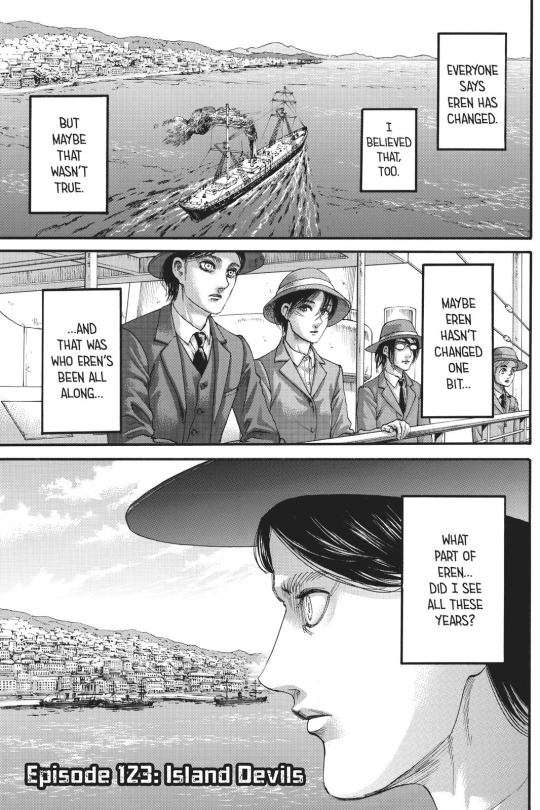
He always had it in him to become the monster that he became. However, he always had a different side to him. A side that had been shown to her a few times. At first, when he wrapped the scarf around her and later when he asked her “What am i to you”. Finally, it manifested as a desire to live quietly with her in their shared dream. It would contradict her development and characterization in the final arc, to have Mikasa start seeing an incomplete Eren again, after realizing earlier who he really was. Mikasa understood who Eren truly is and she accepted him and continued to love him anyway, even though she didn’t agree with his genocide.
It is not out of character for Eren to run away with her either. At least not in that instance. The series highlights the moment that he asked Mikasa “What am i to you” as a pivotal one. Sure, under normal circumstances, Eren would have chosen to fight, but we saw him breaking down just moments earlier. The only person that could have saved him was Mikasa. Alas, that wasn’t meant to happen.
In any instance, the biggest indicator that Mikasa is not just a delusional girl who kissed the decapitated head of the man she loved, when he never really loved her in the same way, is Ymir’s face at the end of the chapter.

Ymir, as i have mentioned in previous posts, is a girl who never knew real love during her lifetime. She didn’t understand what she was looking at, when she first say a couple kissing with their friends cheering them on. And after that she was sentenced to a cruel life, with a man who never loved her and only viewed her as a tool. This girl, remembers longinly that scene of the couple kissing for 2000 years. She was waiting for 2000 years to see real love again.
She witnessed that through Eren and Mikasa. In a scene that would have otherwise been painted in a negative light, Ymir’s warm smile at the sight of the final act of love between two people who never got to be together the way they wanted to, clears any and all doubts regarding Eren’s feelings for Mikasa and the latter’s sanity. Eren reciprocates Mikasa’s feelings and he was alive for enough time to kiss her back, before completely fading away. Eren and Mikasa replaced the married couple and Ymir replaced the crowd that was cheering at them from 2000 years ago.


Of course, one might ask, could Eren really kiss her? Didn’t she just take advantage of him? No, he did kiss her. The way the scene was directed, it shows us that the events, which take place in their dream, mirror the events in real life. Just look at Eren’s lips one moment before Mikasa kissed him and compare them to the picture above, where they kiss. They are different.

Also, you have to remeber that decapitation doesn’t kill immediately and does not immobilize facial muscles. That was the entire reason that Eren and Zeke managed to get the Coordinate. Eren survived long enough from Gabi’s shot to make contact with Zeke. Even his facial expression changes as you can see below:


More importantly, was there really any chance that Ymir would look at Mikasa beheading and kissing Eren, while also smiling in approval, if Mikasa was a delusional girl who was unable to understand Eren’s feelings for her up to the very end? Most of all, do you think she would have allowed him to die, without experiencing real love? She died in such a way and she stayed for 2000 years in the Paths waiting for someone to show her real love. Eren was her benefactor. Would she ever allow him to die in such a way, when she was being mistreated (sexually and in many other ways) by King Fritz? I doubt it. Actually no. I don’t doubt it. I’m sure this is not the way we are meant to interprete the scene.
Eren’s relationship with Mikasa, from the very start, is an allegory for the world of AoT. The world is cruel, but is also very beautiful. Eren’s story with Mikasa starts with him murdering in cold blood her kidnappers (cruelty) and then warmly and gently welcoming her to his family by wrapping a scarf around her (beauty). Their story ends with Mikasa decapitating him (cruelty) and kissing him (beauty).
Eren’s tendency for violence has always been portrayed as going hand in hand with his better side. That side has always been represented by Mikasa. It is only fitting for them to have their most beautiful moment happening almost at the same time as their most cruel one. This is how Isayama juxtaposes this duality:


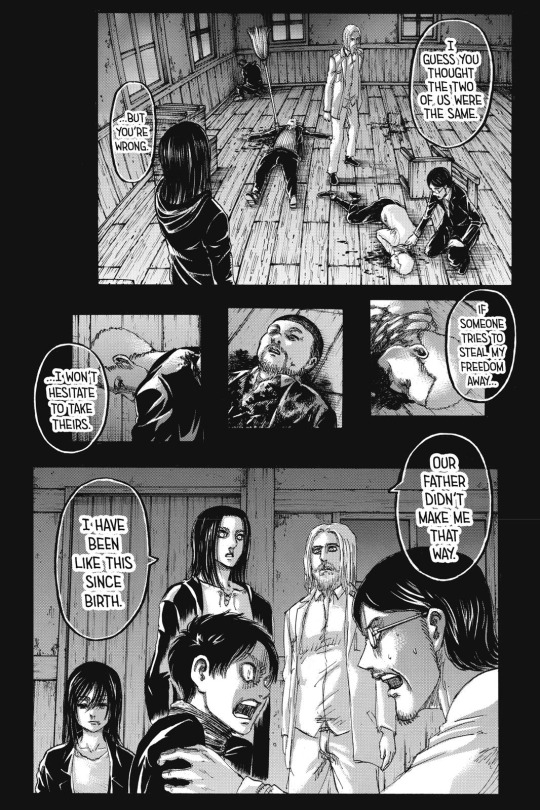


If we interprete this scene as Mikasa being delusional and Eren not being in love with her we get a very disturbing and creepy scene, between an obsessed, psychosis-suffering girl who can’t understand the feelings of Eren, a genocidal maniac who never had any chance or willingness to live a normal life, even though there are hints of that, and a 2000 year old ghost who just happily smiled at the decapitation and forceful kissing of her emancipator. I am pretty sure this is not the message Isayama wants to send. Not simply, because it is a disservice to Mikasa as a character and to her relationship with Eren, which has been one of the most prominent and consistent part of the series from the very first chapter, but because it is also a huge disrespect to Eren as a character as well. Does anyone really think that Isayama would choose to write Eren’s death like that? Not a single important person in the entire story has gotten such an exit. Not even Floch. Even Zeke, who thought that his father never loved him and only used him as a tool, got to see that his father truly did love him, before finally dying. Of course Eren and Mikasa would get the same treatment.
What i mean to say is that Eren and Mikasa’s closure won’t be recontextualized in a way that will paint their feelings for one another and their relationship in a negative light. If anyone’s expecting that, he/she will be disappointed. Eren and Mikasa were confirmed as a canonical couple in chapter 138.
On the other hand, if anyone’s expecting that this wasn’t their real closure and that they will get an even happier ending, he/she is also coping hard. Eren died here in this chapter. There won’t be a scarf rewrap (i’m here to eat my words if it happens), because Isayama gave the couple a kiss. A kiss that was in the makings ever since chapter 50 dropped. And of course, there is not going to be a baby born to Eren and Mikasa. Like, no way it’s happening. Eren is not coming back to life as that would turnish the series and it’s ending.
In conclusion, Eren’s relationship with Mikasa ended in the same way it started. Violently and Beautifully. Tragically and Happily. They acted on their romantic feelings for each other the very moment they had to part ways forever. This is how Isayama hurts us. The essence of a bittersweet conclusion.
EDIT: EATING MY WORDS AS PROMISED. EREN DID REWRAP MIKASA’S SCARF. HE KEPT HIS PROMISE.
#attack on titan#AoT#aot meta#aot 138#aot spoilers#aot theory#shingeki no kyojin#SnK Spoilers#snk theory#SNK analysis#snk meta#snk 138#ymir#shingeki no kyojin ymir#eren yeager#eren#eremika#Mikasa#Mikasa Ackerman#zeke#zeke yeager#floch#kiss#canon#eren x mikasa
2K notes
·
View notes
Note
I remember reading this great post about how succession hints very interestingly at the trope of a rich men killing/destroying the life of a male working-class lover. it's never explicit, but there seems to be a real running undertone. there's the whole vibe with roman and the trainer (and he even jokes about suing him). plus if you look at the conversation kendall was having with the waiter before the car crashed... it's like INCREDIBLY sexually charged. very curious to know your thoughts on this
That's such an interesting observation, anon (and op!) and it's definitely one that I can see. You could even argue I think that Tom and Greg sort of fall into that category too, only the lines are a bit blurred in terms of who's the rich man and who's the working-class lover.
In many ways, I actually tend to think Greg's arc these days most resembles Ripley in Patricia Highsmith's The Talented Mr. Ripley. He's a man in a suit that doesn't belong to him, inserting himself into a life he doesn't really have a place in, and while it's not sexual (they're cousins after all, haha) I think you could argue Kendall's the Dickie to Greg's Ripley – Kendall gives like Dickie does, but Greg has an incident where he oversteps with clothing (Ripley wears Dickie's clothes, and Greg assumes Kendall will buy him the watch, things both characters have been led to believe are okay because of murky boundaries) and then Greg (metaphorically to Ripley's literally) kills Kendall when Kendall tries to break things off with him.
It's a sort of flip in some ways of the trope you're talking about, but I think it operates the same world because both tropes are ultimately untited by class, desire and destruction.
None of these characters are happy, and so the process of seeking happiness becomes one ultimately entangled with desire, and when that thing doesn't offer happiness or sate a desire, the character destroys the thing, whether that be in jest (Roman and the trainer), accidentally (Kendall and Dodds), or deliberately (Logan and, well, everything, haha).
I think class plays a really significant role in all of that too, because class mobility is central to many of the characters motivation on the series. Even Logan's hunger for more power stems from the fact that for his formative years, he had none, and because he can't possibly believe he's now reached the top. Interestingly, I'd argue that feedback loop of desire and destruction is realised there too – he desired to provide a birthright to his children and now resents them for it, so seeks to destroy both them and it.
That sort of psychosexual aspect to desire and destruction's in play there too, I mean, god, the amount of sexual language that gets thrown out amongst the family is constant and often violent.
Which I think makes sense too – power, sex and violence is very often narratively entertwined, and isn't that just another way of saying class, desire and destruction?
But more to your point, yeah I think there's a really compelling and prominent throughline to how all the siblings use people in positions beneath them / the working class in ways that are either sexually coded, like Roman and the trainer, and Kendall and Dodds – both of which, fascinatingly, are reiterated in 3.08 between Shiv telling Logan about the former in the wake of the dick pic, and the latter with Logan asking Kendall straight up if he and Dodds left the wedding to fuck – or outright. Gosh, Connor and Willa are a sort of case in point, as is Shiv trying to bring one of the yacht staffers in for a threesome with her and Tom.
All of these elements are of that same cycle of violence although with Shiv, what gets destroyed is a part of her marriage and not the woman staffer, and for Willa, it's a part of her identity which Connor, by the end of s3, is literally trying to erase. (I could also talk about Willa as a case for the show's class mobility themes here, but that feels like a whole other post, haha). What's significant is that the working class are presented as something to be used by the upper class, and moulded to fit an experience. They function not as their own people, but often markers of a disparity of power and status that charges those with power and those who want power alike.
Roman's trainer moves his body in a way that articulates a physical power over him which Roman flips by toying with him over suing him. Dodds articulates a fantasy about kidnapping Kendall in that car - a desire to have power over the powerful - that Kendall plays along with, confident in his safety as someone with power (although I think you could also read it in a sense that Kendall's not someone who actually wants power, but again, a whole other post, haha). Willa uses Connor's power to build a career she'd never have otherwise, and while there's not a powerplay in the threesome exactly purely because it doesn't go ahead, I think you could argue that there's a shift of power in Shiv's scene with the whistleblower that might not be sexual in itself, but is steeped in the same power, violence, sex trichotomy given what it's about.
With the exception of Connor and Willa, I think these circumstances each involving people of the same sex is significant too because it touches on the way gender is both weaponised and - - mmm, I'm trying to think of the right word, but I guess I'd say a shorthand towards sameness and community? There's a degree of trust in being the same gender, an assumed understanding that your experiences are the same even when they starkly, starkly are not, and I think the show plays with that sort of mirror.
Characters see themselves in others, even when they have no real reason to, and it leaves them thinking the gap between them is smaller than it is. That gap is inviting though, and when they start to play in it, it all goes wrong, and what starts as intriguing becomes boring or repulsive or broken, which ultimately feeds the hungry mouths of desire and destruction all over.
#i hope this makes sense haha#i'm a bit loopy after writing grant applications the last week#i think a lot about how there are almost no actual sex scenes on this show#but how prominently sex is weaponised#a marker of power#it's like how stabbing is usually a phallic attack#at least in terms of narrative symbolism#(but my true crime podcasts tell me in reality too!)#an act of penetration#tom says there's always a top dog in 3.08#but i think the throughline of the show is much more that somebody fucks#and somebody gets fucked#which in itself identifies sex as a sort of violence#as opposed to an act of love or connection that people do together#sex is something done to someone#and it's something that devalues the person who receives#which is So Much to unpack#hbo succession#succession meta#welcome to my ama
40 notes
·
View notes
Text
Historical July IV: Pompeii (2014) - Part II
Let’s talk volcanoes and Vesuvius for a second.

Vesuvius is a still-active stratovolcano, whose profile is one of the most stereotypical volcanoes that you’ll ever see. As a conical volcano, it’s composed of layers of igneous rock and hardened lava and ash. Positioned about 5 miles east of Naples, it’s part of a network of volcanoes in the Campania region. The reason for this is because of tectonic plates.
See, volcanoes tend to form along the boundaries of tectonic plates, where the crust is weak and molten rock can form closer to the surface. The African plate slipped under the European plate, and that eventually results in the formation of the arc that Vesuvius is a part of. Vesuvius is by are the most active of these, regularly producing lava and straight-up erupting last in 1944. But given that its prominence as a volcano is obvious, the question must be asked:
Why settle next to a FIERY DEATH MOUNTAIN?

Easy. Soil. Other than being coastal in the case of Pompeii, volcanic soil makes for VERY good farming, meaning that settlements around or near to volcanoes are historically quite common. Funnily enough, though, the cities around Vesuvius appear to have been founded not for their agricultural activities, but for their port availability. As part of a vital coastal region, the towns had quite a lot of trade coming their way. First settled by the Greeks and Etruscans, the settlements were eventually taken over by the Roman Empire, and had been so for hundreds of years before the events of 79 AD.
Speaking of those events, what actually happened? Well...Vesuvius exploded. But more specifically, things began long before, with earthquakes having shaken the earth around Vesuvius since 217 BC. By the time we get to 79 AD, Pompeii was still rebuilding from the earthquake 17 years before (which, to the film’s credit, if mentioned). Small earthquakes were pretty common, and it mostly went unheeded. And then, well...volcanoes erupt in different ways. Take Mt. St. Helens.

Located in Washington State, Mount St. Helens collapsed in 1980, triggered by an earthquake. This caused an avalanche of debris to DESTROY the area around the volcano, killing 57 people and causing over $3.5 billion in property damage. It’s one of the most famous eruptions in recent history, and was also accompanied with pyroclastic flows. Pyroclastic flows are combinations of hot volcanic gas, ash, pumice, and rock from the volcano itself, also known as tephra. It moves along the ground at over 100 mph (sometimes up to 400 mph), and is a little warm at about 1000 °C. So...not good, is what I’m saying.

Another more recent eruption is that of Puna in 2018, also after a large earthquake hit the island of Hawaii. The shield volcano urged forth volcanic gases and massive lava flows and fountains, the latter of which reached about 300 feet high. While nobody died from this eruption, plenty of people were evacuated, and the property and infrastructure damage was massive. And while the lava flows reached the sea, the fountains produced another fun feature of volcanoes: lava bombs!
Lava bombs are chunks of lava ejected during an eruption. They quickly cool in the air, turning into rock as they hurtle through the air, on their way to fuck up your day. Now, not all volcanoes produce lava bombs, but it’s not unheard of. Also, they tend to explode because of gases trapped inside of them and pressurized as they cool. Yeah, stay away from fucking volcanoes, is what I’m saying.

So, what about Vesuvius? Well, here’s where the Plinys come in. Only two eyewitness accounts of this event are known, coming from famous naturalist Pliny the Elder and his nephew, Pliny the Younger. Elder went to Pompeii to help rescue a friend as the skies began to darken from the building ash cloud. Younger lived across the Bay of Naples, 18 miles away, and could see the plume of ash rising from the mountain. For him, the skies would also grow darker. He and his mother would join the population of Misenum, and evacuate from the coastal settlement as the sea drew back from the shore. Oh, right! I almost forgot!

FUCKING TSUNAMIS
To be fair, there’s no evidence of a major tsunami that accompanied Vesuvius, but tsunamis are associated with volcanoes. The displacement of material from volcanoes can fall into the ocean, causing massive waves to propagate across the ocean’s surface. We refer to some of these massive waves as tsunamis, and they have causes outside of volcanoes. While tsunamis can accompany volcanic eruptions, there probably weren’t massive waves as a result of Vesuvius’ eruption. However, Pliny the Younger’s account does suggest some waves. Either way, he and his mother escaped. But what about Pliny the Elder?
Well, Elder was a naval commander, and was in command of the local Roman fleet. So, he took his boats to Pompeii in order to save his friend, but soon encountered cinders and pumice on their way. He made it to the island, only to find that they couldn’t leave past the showers of pumice. Shit. Pliny went to a friend’s place and, not seeing any other options, took a fucking nap. Yup.

Once he woke up, he and a bunch of others decide to strap some pillows to their heads and leave the darkened city by walking through the bordering fields. Which worked...for everyone but Pliny, who died of asphyxiation, likely from volcanic gases inhaled on the journey. And as for everyone else IN the city...well, that’s when the pyroclastic fumes came down. As they cascaded down the mountain and into Pompeii and the surrounding towns, the bodies in their path were incinerated, and those people likely died instantly.
Pompeii was buried in ash and tephra, for centuries to come. It was rediscovered over 1500 years later, and the dig commences even to this day. Over time, found within the ash were an eerie sight: casts of the dead. See, the ash was so sudden and hot that the people in its path were instantly killed and encased within it. Their bodies decomposed within the ash over time, leaving nothing but bones and the ghostly stone cavities they left behind. When these were discovered in 1864, casts of the spaces were made, giving us the famous Bodies of Pompeii today.

Pompeii is one of the greatest tragedies and archeological finds in the history of man. The people preserved were encased in living death, and we can see how many of them died. Children with syphillis, masters and slaves, sleeping people, the young and the old, and people from different classes and walks of life all have been found in the remains.

And there you have it! That’s the story of Pom...peii, shit. There’s still a second half of this movie. I almost forgot. Here’s Part One if you wanna suffer with me. Let’s get this overwith.
SPOILERS AHEAD!!! AGAIN!!!
Recap: Part II

The gladiatorial exposition takes place in the Amphitheatre of Pompeii, the oldest Roman amphitheater still standing. There, the visiting senator Corvus is “honored” in a fake reenactment of his conquering of the Celts that never happened. And of course, the gladiators end up winning against the invading forces, breaking the reality of the reenactment. Which is unprofessional, guys, that’s not how you do a reenactment, come on.

As they rally, and boy oh boy do they fucking rally, Corvus informs Cassia that he is to marry her, or he’ll make sure that the whole family is killed for besmirching the name of the Emperor. Which is NOT how that would’ve worked for a billion reasons, but whatever. Sutherland is also doing his best Jeremy Irons impression right now, and it’s...it’s not good. I fucking hate this movie, that hasn’t changed. But his dumbass is interrupted by another dumbass.

Milo breaks the flag, then THROWS THE POINTY END AT CORVUS. Yeah, dude tries to kill him right there in the stands. Cassia (and the crowd that’s chanting in their favor) manages to prevent Corvus from killing Milo right there on the spot, and he responds by taking Cassia captive. However, everything is interrupted by the increasing rumbles of the volcano. Corvus also frames this as a divine sign, and has Atticus and Milo taken away. And then...he has Milo fight his soldier Marcus Proculus (Sasha Roiz), kind of out of nowhere.
And as they fight a clearly unbalanced fight, I have to wonder...WHY THE HELL HASN’T THE FUCKING VOLCANO EXPLODED YET? Oh my GOD, I’m so fucking BORED. I don’t care about the revenge wish of this boring-ass edgelord, I JUST WANT TO SEE PEOPLE MELT. And then, as if to answer my annoyance...

YEAH BABY, LET’S ENCASE SOME INNOCENT PEOPLE IN ASHES!
OK, sorry, that was a little too much, I agree, but this movie is so BORING. Anyway, the amphitheater is destroyed, and...THE AMPHITHEATER IS DESTROYED? Dude, this is one of the only structures that actually survived! Fuck off, movie. Milo and Proculus fall beneath the amphitheater, and they...KEEP FIGHTING? THE FUCKING WORLD IS ENDING YOU ASSHOLES, GODDAMN RUN!

The increasing tremors, and fear of retribution by the other gladiators, cause Proculus to run away, and all of the slaves get out. Meanwhile, on the balcony, Corvus ad Cassia’s parents live. Fearing for their daughter, Aurelia asks Severus to kill him, but he’s SO FUCKING SLOW that he fails. Corvus stabs him, then he and Marcus leave them to die on the balcony. But not before Milo also gets up there, where Aurelia asks him to save Cassia, then finally dies. Milo goes to save her, despite Atticus rightfully telling him how crazy this is. The skies finally darken, as hell rains down from the mountain. In the palace on the hill, Ariadne tries to free her, only the entire palace to fall apart anyway.
But of course, who should arrive just in time to save her but Milo. They get her out, and get her water, but then the entire fucking palace falls into the ocean, and Ariadne dies in slow motion as she plummets into the sea. Now, it’s just Cassia and Milo together, and they need to get to the harbor in order to live.

Down in the city, Corvus is trapped by the throngs as the mountain continues to explode. He orders his men to kill the pancking throngs, which obviously didn’t happen in real life. But whatever, it’s fine at this point, right? After all, a BUNCH more people are about to die, because the volcanic eruption is now accompanied by a tsunami. And...yeah, that actually could’ve happened, but not to the city-flooding scale seen in the movie. Still, yes, tsunamis come with volcanic eruptions, so a small one could’ve swamped the shoreline for sure.
Atticus escapes this, and also saves a woman and her child, because of course he does. As he and our couple get to safety, the rocks stop falling, as everyone has died. Cassia asks if this is the end of the world, and ponders why the gods are doing this, or letting this happen. But hey...we ain’t done yet.

As ash rains down on them, the couple reunites with Atticus, and they move together to go to the amphitheatre and get horses. It’s there that they get ambushed by Corvus and his men, including Marcus. Corvus takes Cassia, because the end of the world doesn’t stop the horny. Taking Cassia as his property, he takes off before Mio can stop him. In the CRUMLBING AMPHITHEATRE, Milo and Atticus fight his men and Marcus Proculus, with Atticus staying behind to take Marcus, and Milo chasing after Corvus on a horse while LAVA RAINS FROM THE SKY. PRIORITIES
By the way, small thing, but lava bombs probably weren’t a part of this explosion. What’s to come is going to be far...FAR worse. Anyway, back at the arena, Atticus is killed by Marcus, but not before killing Marcus himself by breaking the sword inside of him, and using the broken piece to stab Marcus in the neck, GODDAMN, ATTICUS THAT WAS BADASS

The chase of Corvus continues, as Cassia manages to free herself, and forces the chariot to crash. But the stupid, STUPID fight isn’t over, as Corvus continues to fight Milo IN A CRUMBLING TEMPLE AS A VOLCANO DESTROYS THE FUCKING CITY
The amounts of stupid this movie is cannot be quantified.

A piece of the mountain destroys the temple they fight in, and ash rains down from the sky as Corvus emerges seemingly victorius. But so does Milo, as he jumps on top of Corvus, and him and Cassia chain him to a column. Milo gets to make a badass speech about his dead people, just as the pyroclastic flow begins. Time to die, boys.

See, searing hot ash is now pouring down from Vesuvius, and is about to kill everything in its wake instantly. The bodies will be buried and encased for hundreds of years, decomposing and leaving imprints in the ash. Those imprints will be cast in plaster, and form the bodies of Pompeii that are so famous today. These include Atticus, who is based on a real possibly North African man found in the city, and the Two Lovers. They would be two figures found clutching each other until covered in ash, and...well, I’ll give Anderson credit...that’s an interesting ending for this movie.

Yup. Milo and Cassia are the Two Lovers, meaning that this entire movie was an elaborate fanfiction to explain this real set of figures. But here’s the thing: they were found embracing, not kissing. And secondly (and this is the funniest part to me)...
THEY WERE MEN. YEAH.
Anderson based this goddamn stupid idiotic movie on two men who some have speculated were actually a gay couple. Holy shit. There is not a better way to end this dumbass fucking movie than that smile on my face.

...How am I gonna be an optimist about this?
Cast and Acting - 4/10: I liked Adewale. That’s it. THAT’S FUCKING IT. Kit Harrington and Emily Browning are boring as hell, Jared Harris is on autopilot (and I like Jared Harris a LOT), Jessica Lucas theoretically exists, Carrie Anne-Moss has one of the worst accents I’ve ever seen in a film like this, and Kiefer Sutherland...WHAT THE FUCK, KIEFER? Trying to be evil Roman Jeremy Irons and failing CATASTROPHICALLY. These guys aren’t inherently bad actors by any means, and I’ve seen something of most of them that I like. But goddamn, Adewale, Browning, and Sutherland REALLY need better agents. Jesus.
Plot and Writing - 2/10: BAD Janet Scott Batchler! BAD Lee Batchler! BAD Michael Robert Johnson! We asked you to write an original movie, not copy everybody else’s homework! I’m sure you’re capable of so much better, like...Batman Forever, oh dear FUCK. Never mind.
Directing and Cinematography - 5/10: ...Look. Paul W.S. Anderson makes shitty, shitty films, but he’s not an incompetent director; he’s just a hacky one, without much personal style or originality. Which, wow, sounded REALLY MEAN. Sorry, lemme change how I say that. He’s not the best. But he isn’t incompetent. Nor is cinematographer Glen MacPherson, who’s not really known for his films work. But whatever; they’re mediocre, nothing wrong with that.
Production and Art Design - 5/10: Eh. It’s boring. Yeah, I know, this film features a mountain exploding, but...you’ve seen one special effects spectacle like this, and they tend to blend into each other. Other than that, this film looks like every other movie I’ve seen, but somehow without a sense of accuracy attached to it. It just looks like a stereotypical action movie of the time, and I have no emotions about it whatsoever. Yawn.
Music and Editing - 7/10: Maybe the only credit I’ll give this movie is the fact that the music...the music is pretty decent. Credit to Clinton Shorer, because his track is suitably epic for the tone of this event, and fitting for the events of this movie. Sound editing is good too, even though the pacing of the film is...is bad. Oh, it’s bad. Still, I don’t really blame editor Michelle Conroy.

42%. Fuck this movie.
Is it the least historically accurate film I’ve ever seen? I’ll be honest, it’s not. It is definitely inaccurate in a lot of ways, but it’s not the worst. Is it a good movie, then? Yeah, no, this movie is terrible, and 42% is far too high a number. Just remember: accurate doesn’t mean good, and inaccurate doesn’t mean bad. God, this movie sucks.
Now for an interesting experiment. Imma fast forward past this era of the Roman Empire, and toward the end of this century. And the next film on my list is technically fiction...but based on fact, so let’s do it. Maybe it’ll be good, huh?

Next: The 13th Warrior (1999); dir. John McTiernan
#pompeii#pompeii 2014#movie: pompeii#paul w.s. anderson#kit harrington#emily browning#keifer sutherland#adewale#adewale akinnuoye-agbaje#jessica lucas#jared harris#carrie-anne moss#historical july#user365#365 days 365 movies#365 film challenge#the eruption of mount vesuvius#vesuvius#mount vesuvius#useramby
74 notes
·
View notes
Text
The Contendings of History and Seth

Seth as a serpent-slayer (MET)
It's safe to say that the myth of Osiris is one of the only non-Greek myths to enjoy a comparable degree of recognition in modern popculture. There are few direct adaptations, sure, but the core narrative is well known, and as a result works themed after ancient Egypt use Seth as a villain almost without fail if only the premise allows the use of fantastical elements.
However, in this article I will instead examine the other side of Seth, and especially his role as a protagonist of myths in his own right, including the historical circumstances of this development. While I mostly want to introduce you to a little known but fascinating world of heroic(?) portrayals of Seth, naturally I will also cover Seth's later loss of relevance and complete vilification to explain why it survived as the dominant tradition.
Early history of Seth
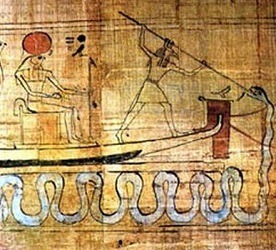
Seth protecting Ra from Apep (wikimedia commons)
From the dawn of recorded history Seth's status in Egyptian religion was ambivalent, and it continues to be a topic of heated debate among researchers what degree of popularity he enjoyed in particular very early on.
Some aspects of Seth character, like his evident interest in both men and women and whether it reflects broader Egyptian cultural norms (or if it’s merely yet another way in which Seth was an outsider among gods and men, as the author of the first monograph dealing with Seth proposed in the 1960s) are likewise a hotly debated topic.
Seth was associated with many animals, such as the hippopotamus and the crocodile, but his main symbol is the sha or “Seth animal” which is regarded as either a mystery or a fictional creation, and in Egyptian texts inhabits zones inhospitable to humans.
Seth was called “the god of confusion” by Herman Te Velde (the first writer to dedicate a monograph to him) and while this opinion has been since called into question, it is undeniable that it’s hard to form a coherent image of him.
In addition to various versions of the well known myth mentioned above there are other instances of combat between Seth and Horus (most likely initially a distinct myth combined with the narrative about Osiris’ death and resurrection at a later date) and of Seth as a menace to the established order. Some of the Pyramid Texts present even the human followers of Seth as enemies to be conquered (which is held by some researchers a mythical memory of strife between local kings before the unification of Egypt). .
However, there are also texts where Seth is a rightful member of the Ennead; where he and Horus act in harmony as protectors of the ruler; where he assists pharaohs in their resurrection in the afterlife; and even to Seth as one of the gods responsible for returning Osiris to life. A recurring motif in texts dealing with the afterlife in particular is a description of Seth offering a ladder to the dead who can reach some destination themselves. Mentuhotep II of the XI dynasty seemingly had Seth and Hathor depicted behind his throne in art; Hatshepsut described Seth positively as well.
Personal names invoking Seth are known, too; and as established by Willam Berg in his studies of a different ambivalent deity, “children are not called after spooks.”
Seth's ambiguous character made him ideal to represent The Other in Egyptian culture – the foreigners, especially these arriving from the Levant, their culture, and generally “un-Egyptian” traits. In that capacity, he functioned as an “ambassador” or “minister of foreign affairs,” to put it in modern terms. Or perhaps a foreigner in his own country, so to speak.
As a result, he came to be associated with a group of deities which, while part of the official pantheon, had their origin outside Egypt.
The Ramessides and foreign gods
Generally speaking, there were two primary sources for foreign deities incorporated into Egyptian religion: Levantine trade centers like Gebal (Byblos in Lebanon) or Ugarit (Ras Shamra in Syria); and Egypt's vassal/enemy/ally/very occasional ruler Nubia (roughly corresponding to present day Sudan).
Libyan influence was smaller, and to my knowledge there is no evidence of any major impact of Egypt's other trading partners (Punt, located near Horn of Africa, and Minoan Crete; the latter absorbed many Egyptian influences instead, though) or enemies (like the Hittites) on religion. The peculiar history of Seth is related to the the first of these areas.
Early researchers saw the “Syrian” deities as worshiped at best by slaves or mercenaries – they didn't fit neatly into the image of Egypt presented by some royal inscriptions: an unmovable, unchanging and homogeneous country, a vision as appealing to absolute rulers in the bronze age as it was to many 19th and 20th century researchers.
However, the truth was much more complex, and in fact some of the best preserved accounts of foreign cults in Egypt indicate that the process was in no small part related to the pharaohs themselves. For example Ramses II in particular was an enthusiast of Anat, as evidenced by statues he left behind:
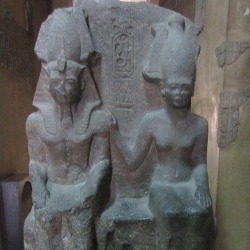
Ramses II and Anat (wikimedia commons)
He also named his daughter Bint-Anat (“daughter of Anat”) and his favorite pets and possessions bore Anat-derived names too.
Not only only Ramses II himself, but the entire XIXth dynasty – the “Ramessides” (a term also applied to the XXth dynasty) - was particularly keen on these imported deities. Curiously, one of its founders was named Seti - “man of Seth,” and Seth was seemingly the tutelary deity of his family. The well known case of Ramses II's red hair might be connected to this – this uncommon trait was associated with Seth.
As a result of the Ramessides' rise to power Seth became one of the state gods in Egypt, alongside heavyweights like Amun, Ptah or Ra. However, it's also safe to say that he was popular in everyday cult among commoners, as evidenced by finds from camps for workers partaking in various construction projects.
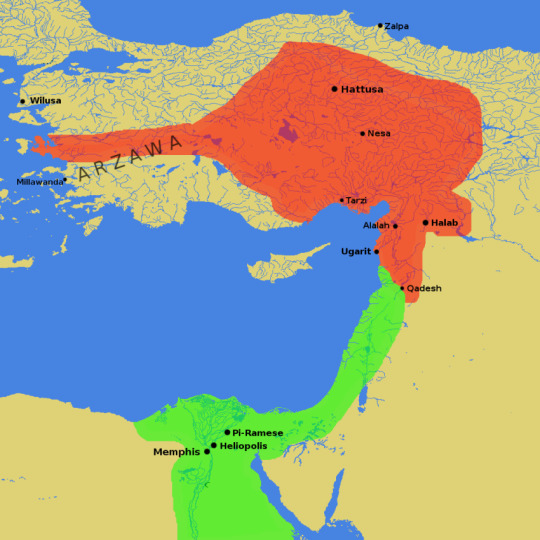
Part of Egypt of the Ramessides at its maximal extent (in green; wikimedia commons)
During the discussed period, Egypt was as the peak of its power, both military and cultural; the “other” recognized Egypt's power. Weaker states in the proximity of Egypt paid tribute, while the more distant fellow “superpowers”of the era (the Hittites and the Mitanni, rivals of Egypt in Syria and the Levant, and the more distant Kassite Babylon) bargained with Egypt for dynastic marriages, luxury goods or craftsmen. While some foreign rulers didn't necessarily get that the pharaohs might not want to play by their rules and expressed frustration with that in their letters sometimes (see a particularly funny example below), overall the relations were positive, and resulted in a lot of interchange between cultures.

(source)
The incorporation of foreign deities into Egyptian pantheon was a phenomenon distinct both from the well known practice of interpretatio graeca and from the monumental Mesopotamian god lists, and foreign gods were adopted rather selectively. Some researchers propose that the incorporated deities were often chosen because their sphere of influence wasn't covered by any native god.
For example, Astarte (more accurately Ashtart or Athtart, considering the Ugaritic orthography; however the Greek spelling is used in literature to refer to the Egyptian version and I'll stick to that) was associated with horses and chariot warfare. As the animal wasn't known in Egypt in the formative period of the state, it wasn't among the symbols of any local deity; at the same time chariots were a prominent component of the Egyptian military at the height of its power, and as such required a deity to be put in charge of it.
Six deities of broadly “Syrian” origin are usually listed among Egyptian gods in modern scholarly literature: Anat, Astarte, Resheph, Houron, Baal (the Ugaritic weather controlling one) and Qadesh. Of these, four were pretty similar to their original versions. Qadesh is a complex case as it's uncertain if such a deity existed outside Egypt – it's possible she developed as a combination of a divine title (“the holy one”) and the general Egyptian perception of foreign religion. Some scholars in the past asserted she is simply Athirat/Asherah but this interpretation relied on the false premise of Athirat forming a trinity with Anat and Ashtart and the three of them being the only prominent goddesses in cities like Ugarit.
There are also curiosities like Chaitau, a god with Egyptian name (“he who appears burning”) but attested only in sources from Levantine cities (though ones written in hieroglyphics) and in magical formulas of similar origin.
Baal is the most puzzling case: simply put, it's clear Baal was introduced to Egypt. It's clear Baal was depicted in Egyptian art. It's even clear that Egyptians knew that Anat and Astarte were deities from Baal's circle back at home, and that Baal was tied to a narrative about combat with the sea. And yet, it's not easy to say where the Egyptian reception of Baal ends and where Seth starts. Baal's name was even written with the Seth animal symbol as determinative. When exactly did this identification first occur is unknown: while it would be sensible to assume the Hyksos, a Canaanite group which settled in Egypt and briefly ruled the Nile delta, are responsible, there is some evidence which might indicate this already happened before.
Baal and Seth
Baal was a natural match for Seth: Seth represented the foreigners, Baal was the most popular god of the foreign group most keen on settling in Egypt; Baal has a somewhat unruly character in myths; both rule over storms and have a pronounced warrior character. Additionally, both of them were depicted as enemies of monstrous serpents.
Baal was identified with Seth in Egypt, but in turn Seth became more Baal-like too. So-called “Stela of year 400” depicts an entity labeled as Seth more similar in appearance to Baal due to the human face and Levantine, rather than Egyptian, garb:
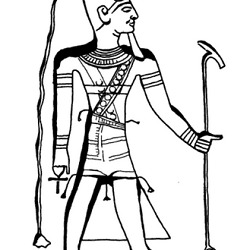
(source)
It is well known that the main myth of Baal, in Ugarit the first part of the “Baal cycle,”describes his combat with the sea, personified by the god Yam, seemingly described both as humanoid and serpentine. In Egypt, this narrative was associated with the composite Seth-Baal, and a fragmentary version is recorded in the so-called Astarte papyrus. Curiously, it was actually discovered long before the Baal cycle itself – however, it only became a subject of in depth studies in the wake of the discovery of Ugarit. There are also many similarities to the Hurrian myth “Song of the Sea,” known only from fragments, and to the Song of Hedammu from Hittite archives.
While in the Ugaritic version Baal fought the personified Sea against the wishes of the head god El, in the Egyptian version the confrontation happens because the Ennead fears Yam, who threatens to flood the earth and demands tribute, much like the Hurrian Sea.
Before Seth properly enters the scene, we learn about how Ptah and Renenutet, a harvest goddess, appeal to his associate Astarte (as already noted before viewed as Ptah's daughter in Egypt), hoping she'll act as a tribute bearer. Astarte is described as a fearsome warrior; however, she is not meant to fight Yam herself, but merely temporarily placate him. She seemingly strips down and brings offerings – this is, once again, closer to the Hurrian than Ugaritic version, where Shaushka, an “Ishtar type” goddess like Astarte, seduces the sea monster Hedammu in a similar way. It is not clear if Yam is interested, though - in fact he appears to question why Astarte isn’t dressed (possibly mocking what must’ve been a humiliating situation for a warrior deity, I’d assume).
Eventually, Seth arrives and presumably fights Yam, likely with Astarte's help - the rest of the papyrus is too poorly preserved to decipher, but as indicated by the foreign equivalents Seth and Astarte win. This is confirmed by the Hearst Medical Papyrus, imploring Seth to expel illness from the treated person just like he vanquished the personified Sea.
The Ugaritic version of the myth doesn’t include a tribute scene among surviving fragments, though it’s worth pointing out that the Ugaritic Ashtart/Astarte cheers on Baal during his battle against Yam and berates him for not acting quick enough, which is easy to interpret as hostility caused by a similar episode. Many researches assume that it existed among the lost fragments of the Baal Cycle tablets, though this is for now purely speculative.
A variant of the myth of Seth and Horus - The Contendings of Horus and Seth - presents a further curious case of Seth-Baal syncretism, this time incorporated into well established Egyptian myth rather than an imported foreign one.
Seth and Horus compete for the right to rule after Osiris' death. Ra thinks Seth is the better option to nominate as a successor because Seth killed Apophis on his behalf, but a few other of the elder gods disagree and try to delay the process by insisting to ask various deities to provide their expert opinions.
These generally favor Horus much to Ra's annoyance, but he can't go against them so he insults Horus (calling him "feeble and weak-limbed" and criticizing his hygiene) but doesn't stop his rise to power. The semi-humorous portrayal of Ra is rather unusual; in addition to showing annoyance with other gods, at one point he vanishes, and only agrees to return because Hathor lured him out.
It seems Horus' mother Isis insults Seth in response to Ra's comments. Seth, offended, refuses to partake in the divine assembly unless Isis leaves; Ra orders that and the gods gather again without her. However, Isis disguises herself and asks Seth who should inherit first, a child or a brother who can provide for himself (and is a foreigner), to which Seth replies that the former; this was a trick, obviously, and Isis holds it as proof that Seth forfeited his right to rule, which Ra accepts.
After multiple chaotic tribulations (including the [in]famous lettuce episode as well as Horus decapitating his mother because he decides she doesn't do enough) Horus is re-declared king but Ra, implored by Ptah (otherwise absent from the myth) gives Seth two wives (eg. Anat and Astarte; this solution was suggested already earlier by the gods providing the opinion; some authors question if they are meant to be Seth’s wives or merely allies, much like the relationship between Baal, Anat and Ashtart in Ugarit is considered debatable) and the storm clouds as his new domain. He is to strike fear into hearts of men, but will also get to be treated as if he were Ra's own son.
Considering the emphasis on storm and the mention of Anat and Astarte, it's pretty clear to me that Egyptians essentially invented their own Baal backstory meant to integrate the foreign tradition with their own by recasting Baal and Seth as the same entity. The text is however unusual because of its humorous tone – the gods insult each other, act ineptly and all around hardly provide an inspiring example. Perhaps the focus on Seth made this possible.
As a final note before I'll move on to times much less prosperous for Seth it's worth to mention that not only Baal but also other foreign gods were at times equated with Seth. The Libyan god Ash was conflated with him in the western oases, while treaties with the Hittites assign the name of Seth to various members of their pantheon, including the Baal-like Tarhunna (equivalent of Hurrian Teshub) but also the sun goddess of Arinna.
Demonization of Seth
While in the late bronze age Seth greatly benefited from his role as a god of foreigners, in later periods this has proven to be his undoing.
Egypt couldn't maintain its power forever, and eventually fell to the Assyrians, who showed little respect for local culture and looted Thebes. While the Assyrian domination was only temporary, it severely damaged the country, and a spiritual scapegoat was needed to reconcile the carnage with the idea that Egypt was a land chosen and protected by the gods.
The change seemingly occurred under the rule of Psamtik – in a new version of the myth of Seth and Horus, Seth not only lost decisively, but also was punished afterwards, and religious texts spoke of a “rebellion”of Seth. Seth was never associated with Ashur, the head god of the Assyrians, before, but in Egyptian imagination he was blamed for bringing the invaders under “his” command to ravage and subjugate the country. A mythical text has Isis implore Ra to punish Seth for robbing temples, much like the Assyrian armies did. Even later accounts tell various tales about Seth being punished, either gruesomely (a few texts recount massacred of towns belonging to Seth) or humorously (for example in one text Thoth makes him impotent with a spell) and exiled from among gods.
There's evidence that the worship of Seth, previously commonplace, came to be abhorred and depictions of Seth were destroyed or altered. A famous example is a Seth statue converted to look like Knhnum or Amun instead:
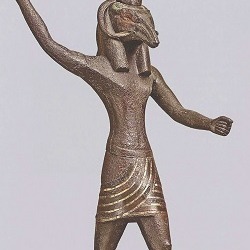
Seth no more (wikimedia commons)
A late relief from Edfu, from the Ptolemaic times, seems to indicate that even Seth's role as a guardian of the solar barge was lost: Seth, depicted as a hippopotamus, was defeated by Horus from the solar barge of Re. However, while Apep is usually depicted as huge and menacing, hippo Seth is tiny and pathetic.
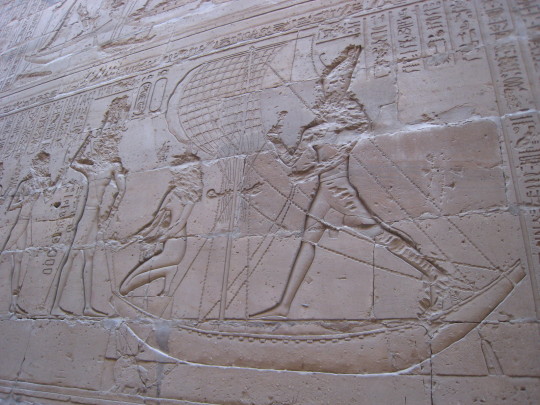
Seth as a tiny hippo representing the forces of chaos (wikimedia commons)
Curiously, despite the official policies, which continued under Ptolemaic rule, it seems that until the 2nd century CE, Seth continued to be popular in the Dahkleh oasis, possibly even serving as the main deity there. Sadly due to lack of research I am unable to provide any more detailed information about that.
Closing remarks
Even further demonization of Seth is evident in the fact that the Greeks and Romans referred to Seth as Typhon, leaving no room for ambiguity of interpretation. As the Greek accounts of the late version of Seth were all that was known for centuries due to ability to read hieroglyphic writing vanishing with the advent of new religions, it remains dominant in media today.
Perhaps it would be beneficial to leave some room for the serpent-slaying hero Seth hanging out with foreign deities in modern works, though? Surely his peculiar outsider status is even more appealing to modern readers than it was to the public of the Ramesside period.
Bibliography
N. Ayali-Darshan, The Other Version of the Story of the Storm-god’s Combat with the Sea in the Light of Egyptian, Ugaritic, and Hurro-Hittite Texts
G. Beckman, Foreigners in the Ancient Near East
M. Dijkstra, Ishtar seduces the Sea-serpent. A New Join in the Epic of Hedammu (KUB 36, 56+95) and its meaning for the battle between Baal and Yam in Ugaritic Tradition
T. J. Lewis, ʿAthtartu’s Incantations and the Use of Divine Names as Weapons
D. Schorsch and M. T. Wypyski, Seth, "Figure of Mystery"
D. T. Sugimoto (ed.), Transformation of a Goddess. Ishtar – Astarte – Aphrodite - especially the chapters ‘Athtart in Late Bronze Age Syrian Texts by M. S. Smith and Astarte in New Kingdom Egypt: Reconsideration of Her Role and Function by K. Tazawa
H. Te Velde, Seth, God of Confusion: A Study of His Role in Egyptian Mythology and Religion
P. J. Turner, Seth - a misrepresented god in the Ancient Egyptian pantheon? (PhD thesis)
C. Zivie-Coche, Foreign Deities in Egypt
110 notes
·
View notes